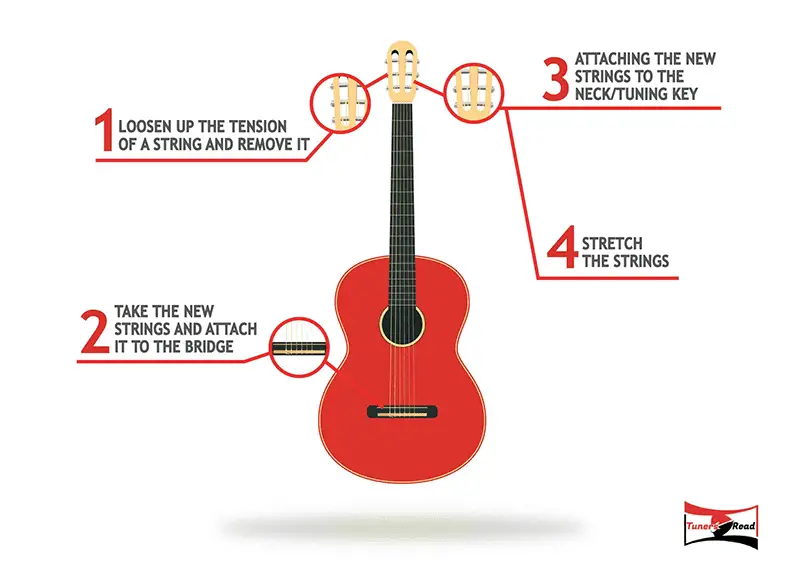A classical guitar is the same as an acoustic guitar, but with strings made of nylon instead of steel or nickel. The lines are also softer than that of acoustic guitars. However, the strings get dull over time and bring out various issues like buzzing, sounding blunt, or not staying in tune. So knowing how to change classical guitar strings is essential.
Get a new set of nylon strings and remove the old strings from the headstock and the bridge end. Feed the upper end of the new string through the hole in the tie block situated on the guitar’s bridge, and pull through. Leave about 3-4 inches to tie the knot on the tie block. Then insert the other end on the tuning peg.
Note that the method to install all the strings is the same, with a variation in the knotting style. The bass strings use one type of knot, and the treble strings just use a different kind of knot.
Why Are Classical Guitar Strings Special?
Classical guitars are also known as nylon string guitars. It has a hollow body with a sound hole that can echo the sound to make it more audible.
The strings in this guitar are made of nylon which is excellent for fingerstyle and plucking. It doesn’t have that much upper fret access. So it is not suitable for solo playing.
This is more of a rhythmic instrument for picking up classical pieces or flamenco music. Mostly this guitar is played with the fingers on the right hand. You have to use your thumb for the bass strings and your index finger and other two fingers for the treble strings.
Finding The Best Classical Guitar Strings
Classical guitars use nylon string. But all the nylon strings on the market are not the same. If you own a nylon string guitar and can’t choose which type of string you should install, follow the next section.
However, remember that this process of changing strings won’t apply to acoustic or electric guitar as they need steel or nickel strings.
String Material
A guitar has six strings. Classical guitar strings are grouped as bass strings and treble strings.
Bass strings are the top 3 strings, including the low E string, A string, and D string. The low E string is the thickest string of the guitar.
Treble strings are the bottom 3 strings. They are thinner and don’t have metal windings. Different strings, including the B string and high E string, have different kinds of tonality.
If you want to string a classical guitar, you should have some ideas about them.
Nylon Treble Strings
For the most part, treble strings are manufactured from the following materials:
- Clear Nylon: Most typical type of string for classical guitars. Remarkable for vibratos and bright tonality.
- Black Nylon: Warm and deep sounding with treble overtones. Great for folk music.
- Titanium: Crisper sound than the previous two.
- Carbon Fiber: Longer-lasting strings.
Nylon Bass Strings
The bass strings of a classical guitar tend to have a multifilament nylon core. The core is wrapped with a metal wire. These winding materials are what make the difference in sound.
Two of the most common choices among the winding materials are:
- Bronze: This type of string has a bright tone and sustain.
- Silver: These are mellow and warm sound-producing strings.
Some people want their guitars to sound bright, whereas some people want a warm and deep sound. All these types have different tonalities in them. So, you should choose according to your preference.
String Gauges
Another critical factor to note is the gauge to choose. However, nylon strings don’t rely that much on gauges. Instead, the tightness of the strings is defined by the tension.
There are low, medium, and high tension strings out there to choose from.
Low Tension String
These strings are not that loud, but they are easier on the fingers. Especially for beginners, low-tension strings would be a great option.
However, they have a caveat along with the low sound, which is fret buzz. Lower tension strings are more prone to buzzing noise. They tend to fall off from the correct pitch more often. The bass string will suffer the most from this problem in low tension strings.
Medium Tension String
Also known as the standard or normal-tension string, these are an excellent place for beginners to start their guitar journey.
If you are unsure which to choose for the first time, you can try medium ones and then go up or down according to your comfort. They are a great balance point between low and high tension strings.
High Tension String
These are hard to play due to their stiff nature. However, keeping the string tight will produce a louder tone when played. This setup is best suited for guitarists who use a lot of strumming in their playing style.
Before installing a high tension string, make sure your classical guitar can take it as they create a lot of pressure on the guitar body and neck.
String Size
The classical guitar has a long history of using nylon strings. The universally-used nylon strings are less apt to break and typically sound warmer than steel-string guitars. However, the size and height of strings for a classical guitar are often determined by the size and shape of the player’s hands.
Suppose you have hands that are small and thin and want to play with thicker strings. Then you might consider having someone else stretch your strings to lower tension. If you have large hands and want to use thin strings, you need someone else to stretch them higher.
There are also many different types of classical guitars, each with its own set of strings. The most common string size is .028 inches, but there are also thicker and thinner strings available.
- Thicker strings: .032, .036, .040
- Thinner strings: .024, .026, .028
When choosing a new set of strings, it’s essential to know the size of your guitar’s neck. You can usually find this information in the guitar’s owner’s manual. If you don’t have the owner’s manual, you can measure the string height at the 12th fret.
Most music stores will have someone who can help you find the right size strings for your guitar. And if the guitar shop doesn’t carry a specific size or type, they can usually order them for you.
String Height at the 12th Fret
Classical guitars have necks that are typically about one inch thick. This measurement is the string height at the 12th fret.
So, the strings for a classical guitar can be .028 inches or thicker. But it will not exceed an overall string height of 1/2-inch at the 12th fret. For example, if your guitar’s neck is 1/2-inch at the 12th fret, you can use .028 inch or thicker strings.
The critical measurement to remember when choosing string height is the overall height of the string on your classical guitar, not just the height at the 12th fret.
Tools Needed to Change Classical Guitar Strings
In order to change strings on a classical guitar, you’ll need different tools. You will also require at least 20 minutes of uninterrupted time as well as patience and care when working with the guitar.
Here’s a basic breakdown of what you’ll need.
The Guitar
The first thing you’ll need is the guitar itself. Make sure the guitar is unplugged and that there are no objects near the strings that could cause them to vibrate.
Hold the guitar, so the headstock (the part with the tuning pegs) is facing your left shoulder if you are right-handed. If you are left-handed, do the opposite and hold the guitar, so the headstock is facing your right shoulder.
New Strings
You will need a new set of strings. Classical guitar strings can be round, flat, or ground wound.
Ground wound strings have a core wire that goes down the length of the string. This takes up excess slack and reduces breakage during playing. Round wound strings are made with a copper wire wrapped around the nylon core, producing a warm tone and more sustain than flat wound strings.
Wire Cutters
The process will also need wire cutters to cut the old strings. You can use any type of wire cutter. But a lineman’s pliers or diagonal cutting pliers work best. You’ll need to purchase wire cutters in addition to the string winder.
Stringing Pliers
A stringing plier is essential to restringing a classical guitar. You can use any type of stringing pliers, including hemostats that are specifically made for the job.
String Winder
A string winder is a helpful tool that makes the process of restringing your guitar much more manageable. They can be purchased at most music stores or online.
Steps to Change Classical Guitar Strings

Changing classical guitar strings is not that hard of a job. An excellent way to start is by replacing the sixth string and going for the bass string first.
In six simple steps, you can do it too! Now that you have all of the tools you need, let’s take a look at the process of restringing your classical guitar.
Step 1: Wind down the old strings
First, loosen the installed strings by turning the tuning pegs. You can do this quickly by using a string winder. A string winder is a tool that will help you loosen or tighten the strings rapidly.
Step 2: Clean up & remove the knot
After removing the string from the top side, remove the guitar string from the guitar’s bridge. Nylon strings are installed via a knot in the bridge of the guitar. Take it off, and the string will also come off.
Before installing a fresh set of strings, you may want to clean the fretboard if it’s dirty. This is not a step but a gentle reminder to clean up your guitar.
Step 3: Insert the new string through the tie block
Install a new set of strings by first feeding the upper end of the new string through the hole in the tie block, which is situated on the guitar’s bridge. Finally, pull the string through.
Note that the two ends of the guitar string are different. Use the wrapped part of the string in the bridge as that is the tail of the string.
Step 4: Tie a new knot
After you have inserted the new strings, you should learn how to tie the string on the classical guitar bridge.
Loop the end of the string back through the loop you’ve created. Keep in mind that the knot stays as far as possible on the tie block. This will prevent the strings from slipping.
Knot tight on the bridge hole. Before you tighten the string, make sure the tail comes down over the white lip. This will aid in the tightening of your knot.
Unlike a steel-string guitar, there are no pegs to remove on a classical guitar. Simply thread the string through the bridge’s hole, loop it around, and tie it off. Just make sure the string is tight and secure before placing it on the tuning peg!
Step 5: Adjust the tuning pegs
Once you’ve adjusted the string on the bridge, it’s time to move on to the tuning pegs.
These pegs have holes in them for the string. Put the string through the hole. Use a string winder to wrap the string in the pegs. Doing it by hand is a tedious job, and that’s why a string winder comes in handy.
Once it is not floppy but not too tight, play and pull gently before moving on to the next string. String stretching is an integral part of the job. Stretching the string before tuning the guitar prevents the notes from falling off now and then.
Step 6: Knot the treble strings
The strings on the treble side, meaning the high E, B, and G strings, don’t have wrapping outside. That’s why the knotting processes of these strings are slightly different. They need double knots on the tie block to prevent slipping.
On new strings, you will find enough string length. Put on the strings and tune it. You can cut the excess string with wire cutters. Nail clippers will also do the job of string cutters. The tuning pegs work in the same direction for the bass strings and the opposite direction for the treble strings.
After doing all these steps, you have finally learned how to restring classical guitars. Now simply tune your guitar to the correct pitch, and you are golden!
Taking Care Of Classical Guitar Strings
A guitar is a lifelong investment. Every guitar player wants his instrument to sound as good as the time of purchase throughout the lifespan of that guitar. If you have a classical guitar, you’d like the same.
But every object depreciates, even the guitar strings. However, you can slow down that process and keep your guitar strings in great shape. Enjoy decent playability all year long if you follow some basic maintenance practices.
Here’s how you can take proper care of your beloved instrument by servicing the strings.
Fretboard and Body Cleaning
Over time, the fretboard of the guitar gets dirty as it gets played. Human fingers have oil and dirt traces in them. The more in contact with the fretboard they get, the more oil and dirt get transferred to the strings.
This dirt and oil affect both the wood and the strings. That’s why it is wise to change the string every 2 – 3 months.
When you are changing the string of the guitar, you might as well clean up the fretboard. You can clean the fretboard by using a soft cloth and a guitar cleaning solution. Generally, there’s lemon oil available on guitar stores which is excellent for cleaning and polishing the fretboard.
Before installing new strings, check the other component of the guitar – like the bridge and the machine heads. The tuning pegs can get jammed due to dust and cause damage to the strings. Use oil to free up the machines.
For cleaning up the body of the guitar, it’s almost the same process. But the solution used for cleaning up the body of the guitar is slightly different. Don’t use a guitar body cleaning solution on the fretboard!
Alignment And Temperature
The guitar’s alignment can get busted due to changes in humidity and temperature. If that is the case, then you’ll find your fretboard bent.
It will cause a guitar string to buzz and play dead notes. To solve this problem, check the alignment and adjust the guitar’s truss rod to the level it becomes even.
Any sudden temperature change will change the tuning of the guitar. The first string gets affected most. Other strings are also affected by this change – mostly the G string. Cold temperature makes the strings sharp, and hot temperature makes the tune flat.
You’ll need a few tools like an Allen wrench to adjust the truss rod. Also, a level is required to check the alignment status.
Storage and Transportation
Storing the guitar in a good place while not playing is also essential if you want to preserve the strings for a long time.
You shouldn’t keep your guitar in a wet or moist place as it will affect the wood of the guitar as well as the string and other machines. Keep the guitar in a cool, dry place when storing.
If you are a touring musician, a guitar case is a must for you. A hard case for your instrument goes a long way as it will protect the strings more than the soft covers.
Frequently Asked Questions (FAQs)
Can I use acoustic strings on classical guitar?
No, You can’t use acoustic strings on classical guitar. Acoustic guitars have bronze or steel strings. In contrast, a classical guitar string is made of Nylon.
If you use acoustic strings as classical guitar strings, the instrument will bend due to excessive tension. So, installing other types of string on your classical guitar will probably damage your instrument.
How often should you do string changes?
String changes should be done every 2-3 months according to regular playing. If your previous string makes a buzzing noise or sounds dull, it’s time to move to the next new string.
How tight should you tie classical guitar strings?
There should be a single knot for the bass strings. For the treble side of strings, two knots should do the job. The Treble side is more prone to slipping. That’s why the knot should be tight in the bridge.
Also, the knot on the tuning post should be tight as well. Make sure there’s no string sticking out. Cut the string tails to avoid any accidents.
Should I change one string or replace the whole set?
If one of your guitar strings is broken, you can change that particular string. But if the whole set you are using is old, then changing the entire set is better.
If you change strings and play both the old and new together, the sound will be different. So, it’s our suggestion to replace the whole set if possible.
Bottom Line
There are many facts and information to know when it comes to the guitar world. Classical guitars are a crucial part of the guitar space as many famous guitar players play classical guitars. But a lot of beginners don’t know how to change classical guitar strings.
So, this post is a little guide to every new guitarist out there who wants to know more about guitars and strings. Now it’s time for you to go and change those old and crappy strings from your classical guitar. Happy Strumming!


